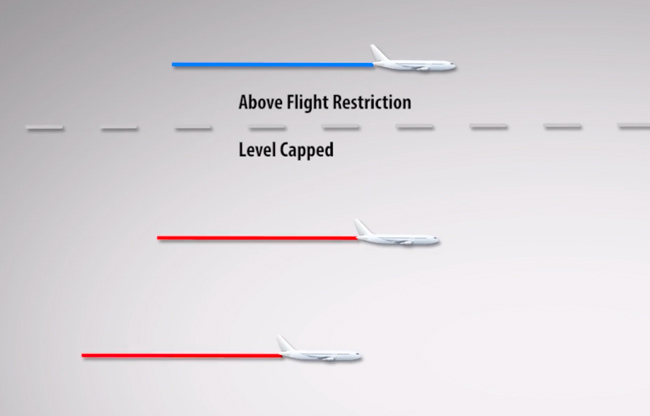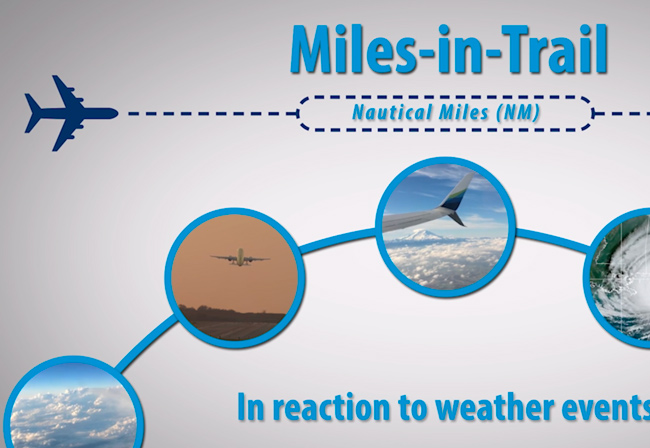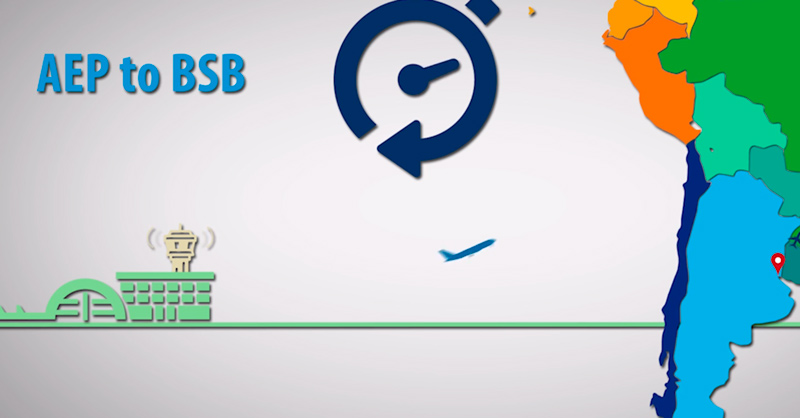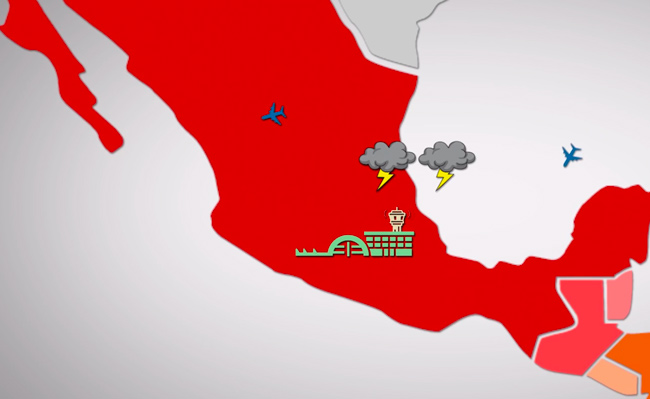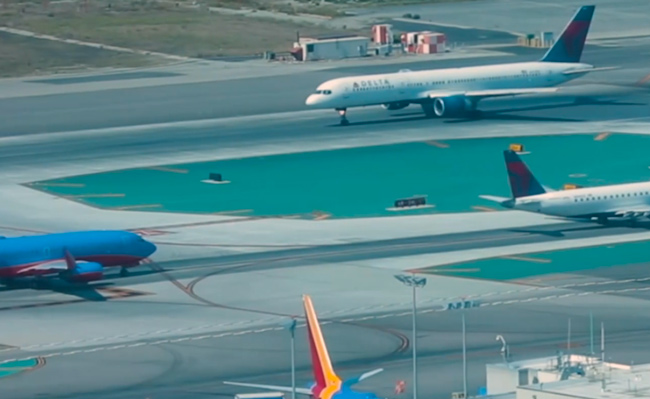Lesson 3: Traffic Flow Management (ATFM)
Introduction
- This lesson covers terminology and methods associated with Air Traffic Flow Management (ATFM).
- Our goal is to provide you with the information you need to safely align system capacity with air traffic demand.
NOTE: Determining airspace and airport capacity will be discussed in lesson 5.
Lesson Outline
- TMC Job Functions
- Traffic Flow Management Measures (TMMs)
- Putting TMMs into Practice
- Quality Control Documentation
Lesson Objectives
- By the end of this lesson, you will be able to identify:
- The five major job functions of a Traffic Management Coordinator (TMC).
- Terms and definitions associated with Air Traffic Flow Management (ATFM) and Traffic Management Measures (TMM).
- The descriptions and methods of implementing TMMs.
- The quality control documentation process.
- You will meet these objectives, with references and in accordance with:
- FAA Orders
- JO 7110.65, Air Traffic Control
- JO 7210.3, Facility Operation and Administration
- ICAO 9971 Manual on Collaborative Air Traffic Flow Management
- Cadena Procedures Manual
3.1 TMC Job Functions
- Analyze the impacting conditions.
- Develop a plan of action for a given constraint.
- Implement restrictions as needed.
- Monitor facility initiatives and the overall system—make sure the TMMs are working and giving controllers what they need.
- Document TMIs/actions taken.
Click each button below for more detail on that job function.
3.2 Traffic Flow Management Measures (TMMs)
- ATFM is the umbrella under which all Traffic Management Measures fall, for all aircraft whether arrival, departure, or en route.
- Properly coordinated and implemented, TMMs are an important tool in the Air Traffic System.
- For example, ATFM applied to arrivals allows aircraft to proceed to the airport in an orderly, preplanned sequence.
- ATFM applied to en route aircraft will allow the aircraft to accept delays under more fuel-efficient conditions.
- In keeping with guidance specified in ICAO DOC 9971, and until automation enables the regional electronic transmittal and communication of TMMs, such as ground delay programs (GDPs), CADENA members agree to use the following TMMs to balance demand and capacity in the Latin American and Caribbean region.
- Level Capping (LVLCP)
- Miles-in-Trail (MIT)
- Minutes-in-Trail (MINIT)
- Minimum Departure Interval (MDI)
- Fix Balancing (FXBAL)
- Reroutes (RERTE)
- Airborne Holding (ABHLD)
- Ground Delay Programs (GDP)
- Ground Stops (GS)
NOTE: This list is not inclusive and does not preclude the innovation and application of other procedures that result in improved customer service.
1. Level Capping
- Level Capping is used to segregate different flows of traffic or to distribute the number of aircraft requesting access to a specified geographic area. It may apply to the departure or arrival phase of flight.
- “Tunneling”
- Descending traffic prior to the normal descent point at an arrival airport to remain clear of an airspace situation on the route of flight.
- “Capping”
- Aircraft cleared to an altitude lower than their requested altitude until clear of the constrained airspace.
- Often, users would rather accept a different route or altitude to avoid departure delays.
2. Miles-in-Trail
- Miles-in-Trail is the most common type of restriction.
- It describes/designates the number of miles required between aircraft departing an airport, over a fix, at an altitude, through a sector, or route specific.
- This restriction is used to apportion traffic into a manageable flow and provide space for additional flights (merging or departing) to enter the flow of traffic.
- It is normally used for aircraft in the same stratum with the same destination or type of route.
3. Minutes-in-Trail
- Minutes-in-Trail designates a specified time interval between aircraft.
- It is generally used between towers and the approach control.
- It’s also used for non-radar/oceanic traffic.
4. Minimum Departure Interval
- Minimum Departure Interval is a program designed to achieve a specified interval between departure aircraft.
- A Minimum Departure Interval (MDI) assigns a departure time to achieve a constant flow of traffic over a common point.
- In some areas, this is sometimes called a Departure Sequencing Program (DSP).
5. Fix Balancing
- To equitably distribute demand and avoid delays, fix balancing assigns an aircraft a different arrival or departure fix than what was filed in the flight plan.
6. Reroutes
- Reroutes are ATC routings other than the filed flight plan. They are issued to ensure aircraft:
- Operate with the flow of traffic.
- Remain clear of special use airspace.
- Avoid congested airspace.
- Avoid areas of known weather or where aircraft are deviating or refusing to fly.
7. Airborne Holding
- There are two types of airborne holding:
- Planned – Aircraft are held to manage a particular situation. This can include ensuring aircraft are available to fill the capacity at the airport.
- Unplanned – Aircraft are held in response to rapidly changing situations, like quickly developing weather or emergencies in the air or on the ground.
8. Ground Delay Program
- In a Ground Delay Program (GDP), aircraft are delayed or “held” on the ground at the point of departure due to a constraint at the destination.
- The purpose of a GDP is to support the TM mission and limit airborne holding.
- (TM mission = balance air traffic demand with system capacity to ensure maximum use of the airspace system.)
- GDPs are flexible and can be implemented in various forms, depending upon the system’s needs.
- GDPs are designed to distribute delays equally among all users.
9. Ground Stop
- During a Ground Stop (GS), aircraft that meet specific criteria must remain on the ground. The criteria may be airport specific, airspace specific, or equipment specific.
- The constraint can be total or partial and may be used whenever a FIR, ACC, TMA or airport experiences a significant reduction in capacity.
- Since GSs are one of the most restrictive methods of traffic management, alternative initiatives are explored first and implemented if appropriate.
Using Ground Stops
- Local Ground Stops should be coordinated with other FIRs as soon as possible.
- Ground Stops are used in severely reduced capacity situations:
- Weather below user minimums.
- Closed runways.
- Aircraft accident.
- Equipment failures.
- Ground Stops are used to prevent:
- Extended periods of airborne holding.
- Sector/Center saturation or airport gridlock.
Reviewing and Canceling a Ground Stop
- When reviewing and canceling a Ground Stop, TMCs need to:
- Review scheduled demand, acceptance rates, and other factors to determine the recovery potential.
- Continue ongoing coordination with affected facilities.
- Ensure system awareness by sending a message via CADENA OIS.
- When canceling a Ground Stop, TMCs need to:
- Communicate with all affected facilities to develop a plan to release ground stopped aircraft.
- Send message via CADENA OIS.
3.3 Putting TMMs into Practice
- When putting TMMs into practice, think systemically to minimize impact.
- It’s important to communicate to ANSPs throughout the region any anticipated constraints as well as your plans for mitigation.
- This is usually done through a daily plan that includes a description of the scenarios, trigger, or timing in which your TMMs would be applied.
- Communicating with the other ANSPs is crucial so you know what they may have planned and to minimize any potential disruptions your TMMs may cause.
- For tactical measures, a two-hour advanced notice is recommended.
- Use systems thinking as you analyze what’s ahead and create your ATFM plan for the day.
- As a TMC, you are looking at the big picture to make that plan.
- How many flights are expected?
- Are there any airport, equipment, or weather constraints?
- Do your neighboring ANSPs have constraints?
- Your plan will include possible TMMs.
- What will prompt you to step in and implement your plan?
- Implementing ATFM doesn’t mean every problem will automatically be solved.
- ATFM is a process that helps you deal with problems.
- You might think your airspace does not have enough air traffic demand to cause a major disruption in air traffic flow. However, weather and other ATFM challenges can happen very quickly.
- One night, a flash thunderstorm caused constraints at an airport in the Caribbean/Latin American region. This caused an immediate need for unplanned airborne holding in Jamaican airspace—several ANSPs away. Here’s what happened from a controller’s perspective:
- With so many variables beyond your control (weather, equipment failures, aircraft incidents), managing air traffic flow will always be a dynamic challenge.
- But with ATFM, you can learn and apply those lessons to your plan so you are better prepared next time.
The Restriction Process
Tap each step to see why it is important.
Step 1: Exploration
Field facility responsibilities include:
- Assess demand versus capacity.
- Gather and evaluate all data including, but not limited to, counts and lists from the traffic database in coordination with facilities under the requesting facility’s jurisdiction.
- Listen and share information to increase situational awareness.
- To get a sense of what a typical assessment is like, listen to this sample CADENA planning telecon:
CADENA Operations Planning Teleconference, 20 August, 2020
Step 2: Justification
- Consider internal options before requesting interfacility initiatives.
- When interfacility TMMs are appropriate, field facilities should coordinate with other FIRs to provide the following:
- Specific identification of the problem.
- Intrafacility actions taken or proposed.
- Detailed explanation of the assistance required, including additional options available.
- Identification of potential system impacts, both if enacted and if denied.
Step 3: Implementation
- When implementing initiatives, field facilities need to notify other facilities under their jurisdiction as well as their appropriate facility personnel.
Step 4: Validation
- Facility TMCs need to:
- Validate actual system impact and dynamically adjust measures as required.
- Record actual impact for use in developing future restrictions.
- Continually monitor the TMMs.
- Periodically examine air traffic lists and counts (or any data that the TMC has).
- Frequently examine meteorological data.
Step 5: Critique
- Critique involves multi-directional feedback among users and facilities.
- Obtain feedback from affected facilities and other ANSP areas affected by the TMM.
Step 6: Review
- Where possible, the FIR FMU should develop and maintain a restriction database for historical/statistical analysis.
- This database could be used to identify successful TMMs for addressing reoccurring system constraints.
3.4 Quality Control Documentation
- Fulfilling the ATFM mission means flights arrive at their destination safely and with minimal delays. To achieve this, it’s important to assess your facility’s performance and that of other regional facilities. Quality control documentation is crucial for this.
- The quality control documentation process includes:
- Using the CADENA OIS page or other facility mechanisms, the TMC records facility ATFM information, including outage reports and the following TMMs: Miles in Trail (MIT), Minutes in Trail (MINIT), Ground Stops (GS), Ground Delays (GDP).
- The TMC records stakeholder input, shift summaries, and end of shift comments.
- Facility management reviews the input to evaluate the performance of the operation.
- Air traffic managers discuss what worked and what didn’t work.
- The information is kept in a database for future reference.
- Air traffic managers learn and develop future expertise from this information.
- QC documentation enables air traffic managers to better understand problems, be responsive to stakeholder’s inquiries, and encourage improvements.
- Problem areas are highlighted and researched to learn ways to improve.
Resources
In this lesson, you learned:
- A variety of TMMs are used to balance traffic demand and system capacity.
- You have a role in planning and implementing traffic flow restrictions.
- Why it is so important to communicate with your stakeholders and neighboring FIRs about constraints and planned restrictions.
- Documenting delays and other ATFM challenges build historical knowledge and expertise.
Lesson 3 Knowledge Check
 Lesson 3 Knowledge CheckMultiple Choice
Lesson 3 Knowledge CheckMultiple Choice